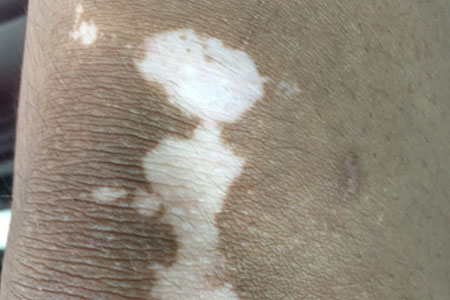Vitiligo
What is vitiligo?
Vitiligo is a pigmentation disorder in which melanocytes—the cells that make pigment—in the skin are destroyed. Once the melanocytes are destroyed, white patches surface on the skin. These white patches may appear on any location of the body and in many areas. This destruction is thought to be due to an acquired autoimmune problem, but the cause is unknown.
Who is affected by vitiligo?
About 0.5 to 1 percent of the world's population, or as many as 65 million people, have vitiligo. In the United States, 1 to 2 million people have the disorder. Half the people who have vitiligo develop it before age 20; most develop it before their 40th birthday. The disorder affects both sexes and all races equally; however, it is more noticeable in people with dark skin.
What does vitiligo look like?
Those who develop vitiligo usually first notice white patches (depigmentation) on their skin, most commonly on sun-exposed areas of the body, including the hands, feet, arms, face, and lips. Other commonly affected areas are the armpits, groin and around the mouth, eyes, nostrils and navel.
The disorder generally appears in one of three patterns:
What are the emotional and psychological effects of vitiligo?
Although vitiligo is not usually harmful medically and causes no physical pain, its emotional and psychological effects can be deeply disturbing. Regardless of a person's race and culture, white patches of vitiligo can cause emotional stress, particularly if the condition develops on visible areas of the body (such as the face, hands, arms, and feet) or on the genitals. Adolescents, who are often particularly concerned about their appearance, can be devastated by widespread vitiligo. Some people who have vitiligo feel embarrassed, ashamed, depressed, or worried about how others will react.
What is the treatment for vitiligo?
When you are first diagnosed with vitiligo, your doctor will prescribe different topical medications and possibly oral medications to see if they help improve your vitiligo. Other treatment options include the XTRAC Excimer Laser to repigment vitiligo. Schedule an appointment to see which treatment is best for you.
Vitiligo is a pigmentation disorder in which melanocytes—the cells that make pigment—in the skin are destroyed. Once the melanocytes are destroyed, white patches surface on the skin. These white patches may appear on any location of the body and in many areas. This destruction is thought to be due to an acquired autoimmune problem, but the cause is unknown.
Who is affected by vitiligo?
About 0.5 to 1 percent of the world's population, or as many as 65 million people, have vitiligo. In the United States, 1 to 2 million people have the disorder. Half the people who have vitiligo develop it before age 20; most develop it before their 40th birthday. The disorder affects both sexes and all races equally; however, it is more noticeable in people with dark skin.
What does vitiligo look like?
Those who develop vitiligo usually first notice white patches (depigmentation) on their skin, most commonly on sun-exposed areas of the body, including the hands, feet, arms, face, and lips. Other commonly affected areas are the armpits, groin and around the mouth, eyes, nostrils and navel.
The disorder generally appears in one of three patterns:
- FOCAL, where depigmentation is limited to one or only a few areas.
- SEGMENTAL, where patches develop on one side of the body only.
- GENERALIZED PATTERN—the most common pattern—where depigmentation occurs symmetrically on both sides of the body.
What are the emotional and psychological effects of vitiligo?
Although vitiligo is not usually harmful medically and causes no physical pain, its emotional and psychological effects can be deeply disturbing. Regardless of a person's race and culture, white patches of vitiligo can cause emotional stress, particularly if the condition develops on visible areas of the body (such as the face, hands, arms, and feet) or on the genitals. Adolescents, who are often particularly concerned about their appearance, can be devastated by widespread vitiligo. Some people who have vitiligo feel embarrassed, ashamed, depressed, or worried about how others will react.
What is the treatment for vitiligo?
When you are first diagnosed with vitiligo, your doctor will prescribe different topical medications and possibly oral medications to see if they help improve your vitiligo. Other treatment options include the XTRAC Excimer Laser to repigment vitiligo. Schedule an appointment to see which treatment is best for you.


